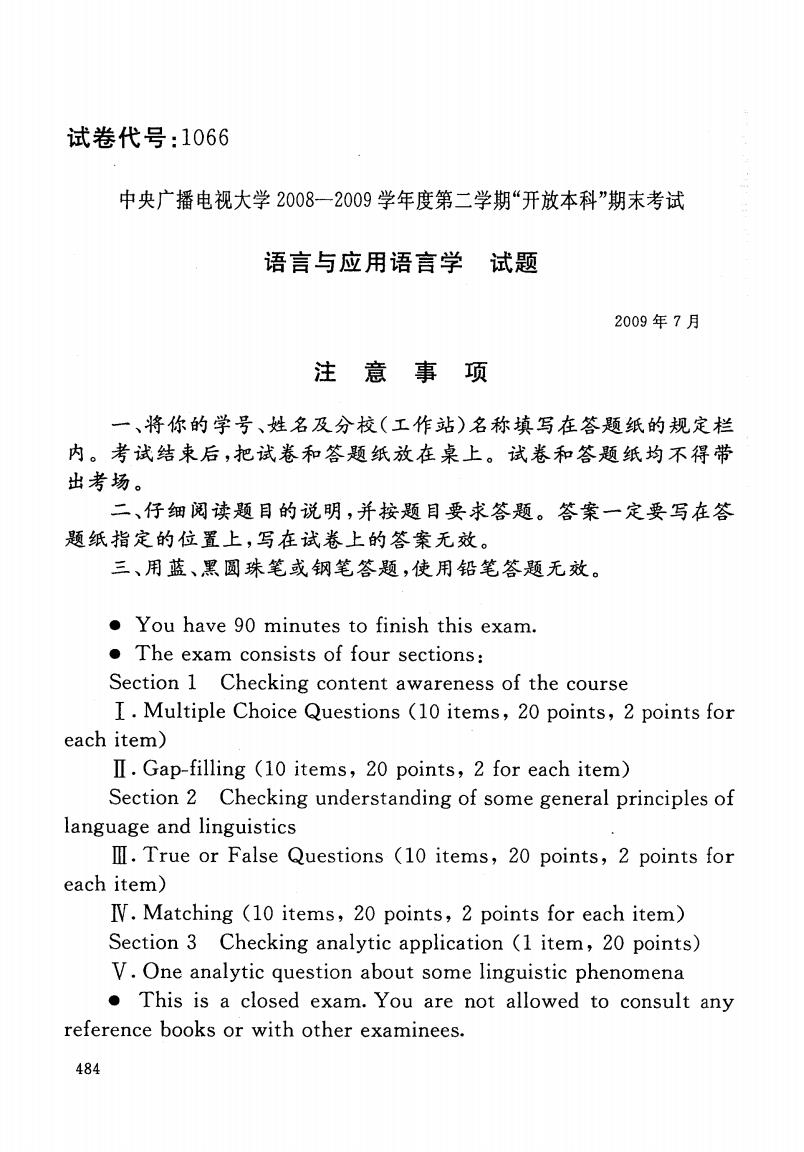
试卷代号:1066 中央广播电视大学2008一2009学年度第二学期“开放本科”期末考试 语言与应用语言学试题 2009年7月 注意事项 一、将你的学号、姓名及分校(工作站)名称填写在答题纸的规定栏 内。考试结束后,把试卷和答题纸放在桌上。试卷和答题纸均不得带 出考场。 二、仔细阅读题目的说明,并按题目要求答题。答案一定要写在答 题纸指定的位置上,写在试卷上的答案无效。 三、用蓝、黑圆珠笔或钢笔答题,使用铅笔答题无效。 You have 90 minutes to finish this exam. The exam consists of four sections: Section 1 Checking content awareness of the course I.Multiple Choice Questions (10 items,20 points,2 points for each item) II.Gap-filling (10 items,20 points,2 for each item) Section 2 Checking understanding of some general principles of language and linguistics II.True or False Questions (10 items,20 points,2 points for each item) IV.Matching (10 items,20 points,2 points for each item) Section 3 Checking analytic application (1 item,20 points) V.One analytic question about some linguistic phenomena This is a closed exam.You are not allowed to consult any reference books or with other examinees. 484
试卷代号:1066 中央广播电视大学2008-2009学年度第二学期“开放本科”期末考试 语言与应用语言学 试题 2009年 7月 之闪卜 口己匕 侧片 下口口 J土 左 畏R 192 一、将你的学号、姓名及分校(工作站)名称填写在答题纸的规定栏 内。考试结束后,把试卷和答题纸放在桌上。试卷和答题纸均不得带 出考场。 二、仔细阅读题目的说明,并按题目要求答题。答案一定要写在答 题纸指定的位置上,写在试卷上的答案无效。 三、用蓝、黑圆珠笔或钢笔答题 ,使用铅笔答题无效。 . You have 90 minutes to finish this exam. . The exam consists of four sections: Section 1 Checking content awareness of the course I.Multiple Choice Questions(10 items,20 points,2 points for each item) I.Gap-filling(10 items,20 points,2 for each item) Section 2 Checking understanding of some general principles of language and linguistics IU.True or False Questions(10 items,20 points,2 points for each item) N.Matching(10 items,20 points,2 points for each item) Section 3 Checking analytic application(1 item,20 points) V.One analytic question about some linguistic phenomena . This is a closed exam. You are not allowed to consult any reference books or with other examinees. 484
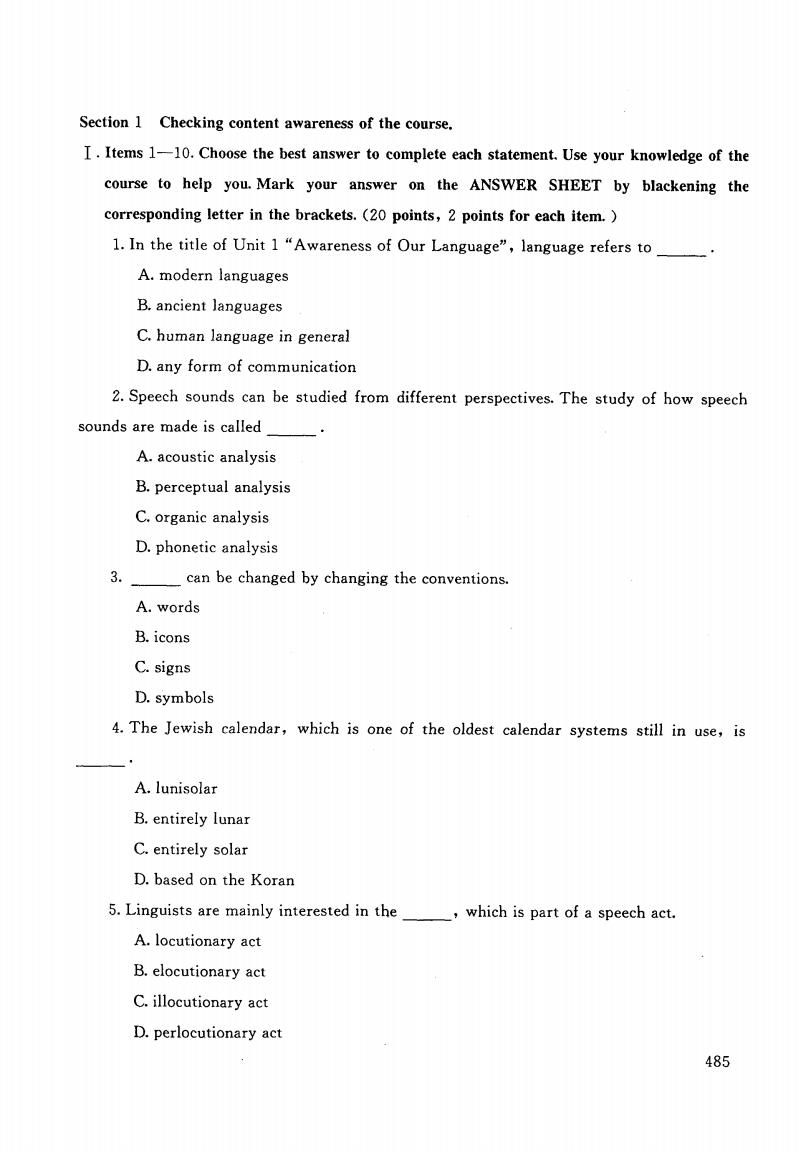
Section 1 Checking content awareness of the course. I.Items 1-10.Choose the best answer to complete each statement.Use your knowledge of the course to help you.Mark your answer on the ANSWER SHEET by blackening the corresponding letter in the brackets.(20 points,2 points for each item. 1.In the title of Unit 1 "Awareness of Our Language",language refers to A.modern languages B.ancient languages C.human language in general D.any form of communication 2.Speech sounds can be studied from different perspectives.The study of how speech sounds are made is called A.acoustic analysis B.perceptual analysis C.organic analysis D.phonetic analysis can be changed by changing the conventions. A.words B.icons C.signs D.symbols 4.The Jewish calendar,which is one of the oldest calendar systems still in use,is A.lunisolar B.entirely lunar C.entirely solar D.based on the Koran 5.Linguists are mainly interested in the,which is part of a speech act. A.locutionary act B.elocutionary act C.illocutionary act D.perlocutionary act 485
Section 1 Checking content awareness of the course. I.Items 1一10. Choose the best answer to complete each statement. Use your knowledge of the course to help you. Mark your answer on the ANSWER SHEET by blackening the corresponding letter in the brackets. (20 points, 2 points for each item.) 1. In the title of Unit 1 "Awareness of Our Language",language refers to A. modern languages B. ancient languages C. human language in general D. any form of communication 2. Speech sounds can be studied from different perspectives. The study of how speech sounds are made is called A. acoustic analysis B. perceptual analysis C. organic analysis D. phonetic analysis 3._ can be changed by changing the conventions. A. words B. icons C. signs D. symbols 4. The Jewish calendar, which is one of the oldest calendar systems still in use, is A. lunisolar B. entirely lunar C. entirely solar D. based on the Koran 5. Linguists are mainly interested in the_ ,which is part of a speech act. A. locutionary act B. elocutionary act C. illocutionary act D. perlocutionary act 485
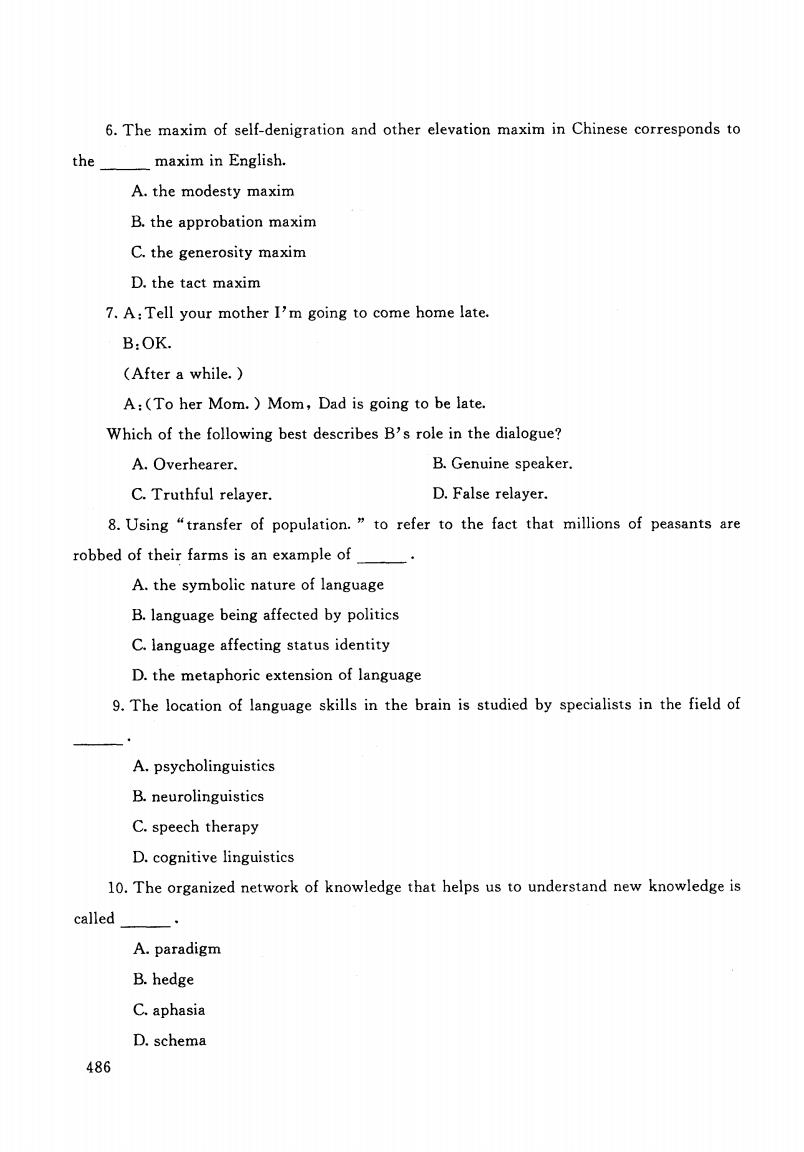
6.The maxim of self-denigration and other elevation maxim in Chinese corresponds to the maxim in English A.the modesty maxim B.the approbation maxim C.the generosity maxim D.the tact maxim 7.A:Tell your mother I'm going to come home late. B:OK. (After a while. A:(To her Mom.Mom,Dad is going to be late. Which of the following best describes B's role in the dialogue? A.Overhearer. B.Genuine speaker. C.Truthful relayer. D.False relayer. 8.Using "transfer of population.to refer to the fact that millions of peasants are robbed of their farms is an example of A.the symbolic nature of language B.language being affected by politics C.language affecting status identity D.the metaphoric extension of language 9.The location of language skills in the brain is studied by specialists in the field of A.psycholinguistics B.neurolinguistics C.speech therapy D.cognitive linguistics 10.The organized network of knowledge that helps us to understand new knowledge is called A.paradigm B.hedge C.aphasia D.schema 486
6. The maxim of the m ax im in self-denigration and other elevation maxim in Chinese corresponds to English. A. the modesty maxim B. the approbation maxim C. the generosity maxim D. the tact maxim 7. A:Tell your mother I'm going to come home late. B: OK. (After a while.) A: (To her Mom.)Mom, Dad is going to be late. Which of the following best describes B's role in the dialogue? A. Overhearer. B. Genuine speaker. C. Truthful relayer. D. False relayer. 8. Using“transfer of population.”to refer to the fact that millions of peasants are robbed of their farms is an example of_ . A. the symbolic nature of language B. language being affected by politics C. language affecting status identity D. the metaphoric extension of language 9. The location of language skills in the brain is studied by specialists in the field of A. psycholinguistics B. neurolinguistics C. speech therapy D. cognitive linguistics 10. The organized network of knowledge that helps us to understand new knowledge is called A. paradigm B. hedge C. aphasia D. schema 486
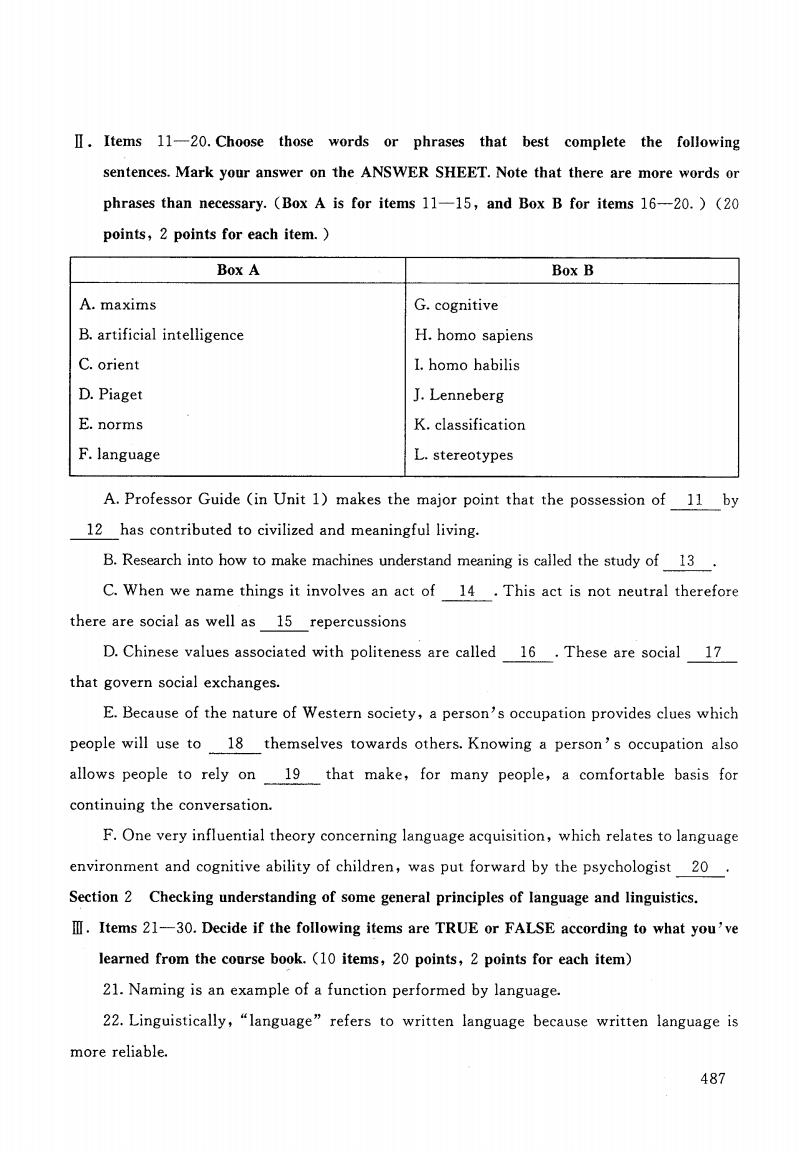
II.Items 11-20.Choose those words or phrases that best complete the following sentences.Mark your answer on the ANSWER SHEET.Note that there are more words or phrases than necessary.(Box A is for items 11-15,and Box B for items 16-20.)(20 points,2 points for each item. Box A Box B A.maxims G.cognitive B.artificial intelligence H.homo sapiens C.orient I.homo habilis D.Piaget J.Lenneberg E.norms K.classification F.language L.stereotypes A.Professor Guide (in Unit 1)makes the major point that the possession of 11 by 12 has contributed to civilized and meaningful living. B.Research into how to make machines understand meaning is called the study of 13. C.When we name things it involves an act of 14.This act is not neutral therefore there are social as well as 15 repercussions D.Chinese values associated with politeness are called 16.These are social 17 that govern social exchanges. E.Because of the nature of Western society,a person's occupation provides clues which people will use to 18 themselves towards others.Knowing a person's occupation also allows people to rely on 19 that make,for many people,a comfortable basis for continuing the conversation. F.One very influential theory concerning language acquisition,which relates to language environment and cognitive ability of children,was put forward by the psychologist 20. Section 2 Checking understanding of some general principles of language and linguistics. III.Items 21-30.Decide if the following items are TRUE or FALSE according to what you've learned from the course book.(10 items,20 points,2 points for each item) 21.Naming is an example of a function performed by language. 22.Linguistically,"language"refers to written language because written language is more reliable. 487
I.Items 11-20. Choose those words or phrases that best complete the following sentences. Mark your answer on the ANSWER SHEET. Note that there are more words or phrases than necessary. (Box A is for items 11一15,and Box B for items 16-20.)(20 points, 2 points for each item.) Box A Box B A. maxims B. artificial intelligence C. orient D. Piaget E. norms F. language G. cognitive H. homo sapiens I. homo habilis 7. Lenneberg K. classification L. stereotypes A. Professor Guide (in Unit 1) makes the major point that the possession of 11 by 12 has contributed to civilized and meaningful living. B. Research into how to make machines understand meaning is called the study of 13 C. When we name things it involves an act of 14 .This act is not neutral therefore there are social as well as 15 repercussions D. Chinese values associated with politeness are called 16 .These are social 17 that govern social exchanges. E. Because of the nature of Western society, a person's occupation provides clues which people will use to 18 themselves towards others. Knowing a person’s occupation also allows people to rely on 19 that make, for many people, a comfortable basis for continuing the conversation. F. One very influential theory concerning language acquisition, which relates to language environment and cognitive ability of children, was put forward by the psychologist 20 Section 2 Checking understanding of some general principles of language and linguistics. 1.Items 21一30. Decide if the following items are TRUE or FALSE according to what you've learned from the course book. (10 items, 20 points, 2 points for each item) 21.Naming is an example of a function performed by language. 22. Linguistically, "language" refers to written language because written language is more reliable. 487
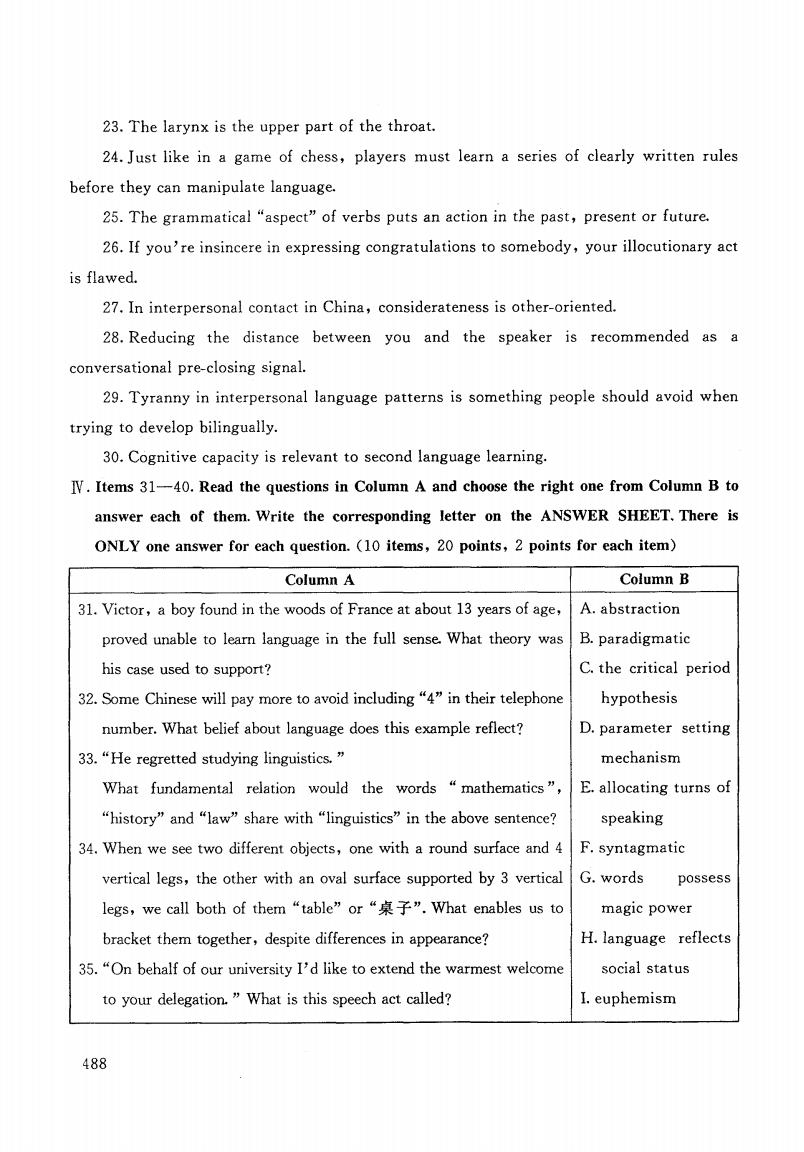
23.The larynx is the upper part of the throat. 24.Just like in a game of chess,players must learn a series of clearly written rules before they can manipulate language. 25.The grammatical "aspect"of verbs puts an action in the past,present or future. 26.If you're insincere in expressing congratulations to somebody,your illocutionary act is flawed. 27.In interpersonal contact in China,considerateness is other-oriented. 28.Reducing the distance between you and the speaker is recommended as a conversational pre-closing signal. 29.Tyranny in interpersonal language patterns is something people should avoid when trying to develop bilingually. 30.Cognitive capacity is relevant to second language learning. IV.Items 31-40.Read the questions in Column A and choose the right one from Column B to answer each of them.Write the corresponding letter on the ANSWER SHEET.There is ONLY one answer for each question.(10 items,20 points,2 points for each item) Column A Column B 31.Victor,a boy found in the woods of France at about 13 years of age, A.abstraction proved unable to learn language in the full sense.What theory was B.paradigmatic his case used to support? C.the critical period 32.Some Chinese will pay more to avoid including"4"in their telephone hypothesis number.What belief about language does this example reflect? D.parameter setting 33.“He regretted studying linguistics..” mechanism What fundamental relation would the words "mathematics", E.allocating turns of “history'”and“law”share with“linguistics”in the above sentence?? speaking 34.When we see two different objects,one with a round surface and 4 F.syntagmatic vertical legs,the other with an oval surface supported by 3 vertical G.words possess legs,we call both of them“table”or“桌子”.What enables us to magic power bracket them together,despite differences in appearance? H.language reflects 35."On behalf of our university I'd like to extend the warmest welcome social status to your delegation."What is this speech act called? I.euphemism 488
23. The larynx is the upper part 24. Just like in a game of chess of the throat. players must learn a series of clearly written rules before they can manipulate language. 25.The grammatical "aspect" of verbs puts an action in the past, present or future. 26. Ifyou're insincere in expressing congratulations to somebody, your illocutionary act is flawed. 27. Ininterpersonal contact in China, considerateness is other-oriented. 28. Reducing the distance between you and the speaker is recommended as a conversational pre-closing signal. 29. Tyranny in interpersonal language patterns is something people should avoid when trying to develop bilingually. 30. Cognitive capacity is relevant to second language learning. W.Items 31-40. Read the questions in Column A and choose the right one from Column B to answer each of them. Write the corresponding letter on the ANSWER SHEET. There is ONLY one answer for each question. (10 items, 20 points, 2 points for each item) Column A Column B 31. Victor, a boy found in the woods of France at about 13 years of age, proved unable to learn language in the full sense. What theory was his case used to support? 32. Some Chinese will pay more to avoid including "4" in their telephone number. What belief about language does this example reflect? 33. "He regretted studying linguistics.” What fundamental relation would the words “mathematics”, "history" and "law" share with "linguistics" in the above sentence? 34. When we see two different objects, one with a round surface and 4 vertical legs, the other with an oval surface supported by 3 vertical legs, we call both of them "table" or“桌子”. What enables us to bracket them together, despite differences in appearance? 35. "On behalf of our university I'd like to extend the warmest welcome to your delegation.”What is this speech act called? A. abstraction B. paradigmatic C. the critical period hypothesis D. parameter setting mechanism E. allocating turns of speaking F. syntagmatic G. words possess magic power H. language reflects social status I. euphemism 488
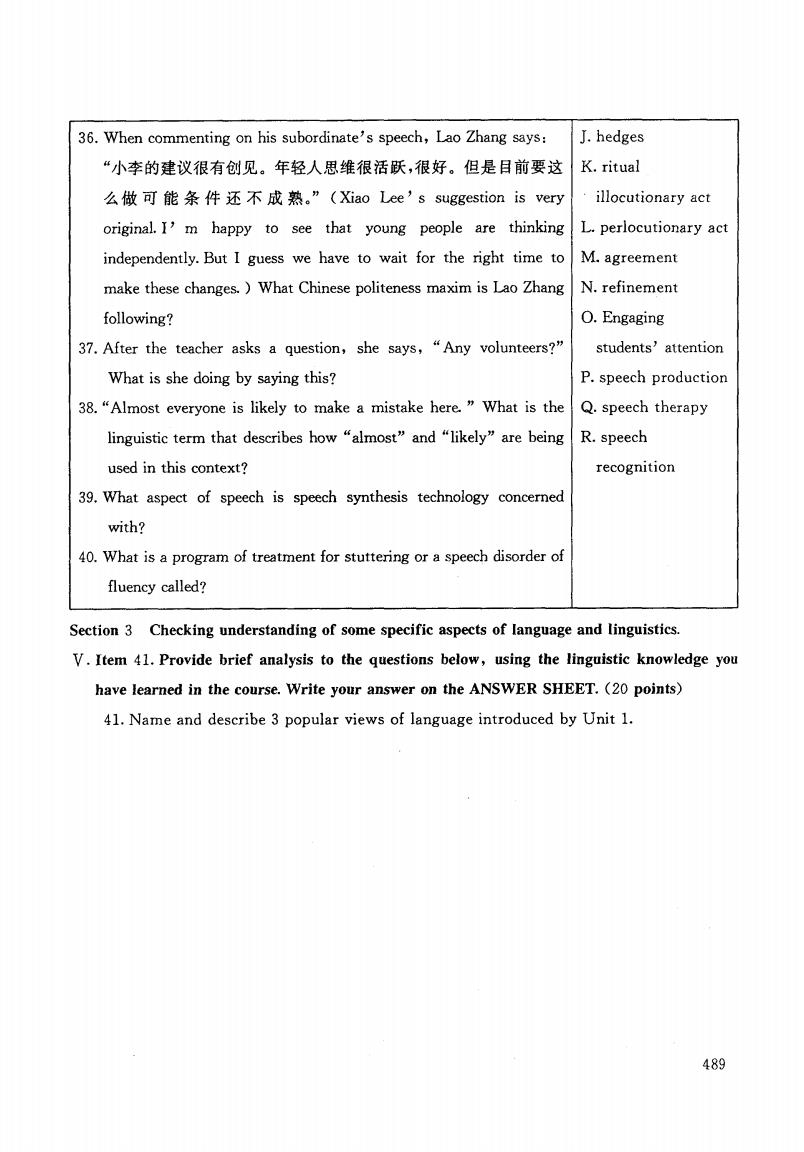
36.When commenting on his subordinate's speech,Lao Zhang says: J.hedges “小李的建议很有创见。年轻人思维很活跃,很好。但是目前要这 K.ritual 么做可能条件还不成熟。”(Xiao Lee's suggestion is very illocutionary act original.I'm happy to see that young people are thinking L.perlocutionary act independently.But I guess we have to wait for the right time to M.agreement make these changes.)What Chinese politeness maxim is Lao Zhang N.refinement following? O.Engaging 37.After the teacher asks a question,she says,"Any volunteers?" students'attention What is she doing by saying this? P.speech production 38."Almost everyone is likely to make a mistake here.What is the Q.speech therapy linguistic term that describes how“almost'”and“likely”are being R.speech used in this context? recognition 39.What aspect of speech is speech synthesis technology concerned with? 40.What is a program of treatment for stuttering or a speech disorder of fluency called? Section 3 Checking understanding of some specific aspects of language and linguistics. V.Item 41.Provide brief analysis to the questions below,using the linguistic knowledge you have learned in the course.Write your answer on the ANSWER SHEET.(20 points) 41.Name and describe 3 popular views of language introduced by Unit 1. 489
36. When commenting on his subordinate's speech, Lao Zhang says: “小李的建议很有创见。年轻人思维很 活跃,很好。但是 目前要这 么做可能条件还不成熟。" ( Mao Lee' s suggestion original. I’m happy to see that independently. But I guess we have young people are is very thinking J. hedges K.ritual illocutionary act L. perlocutionary act to wait for the right time to】M. make these changes.)What Chinese politeness maxim is Lao Zhang following? 37. After the teacher asks a question, she says,“Any volunteers?" What is she doing by saying this? agreement refinement P 38. "Almost everyone is likely to make a mistake here.”What is the}Q. linguistic term that describes how "almost" and "likely" are being used in this context? 39. What aspect of speech is speech synthesis technology concerned with? 40. What is a program of treatment for stuttering or a speech disorder of fluency called? R Engaging students' attention speech production speech therapy speech recognition N O Section 3 Checking understanding of some specific aspects of language and linguistics. V.Item 41. Provide brief analysis to the questions below, using the linguistic knowledge you have learned in the course. Write your answer on the ANSWER SHEET. (20 points) 41.Name and describe 3 popular views of language introduced by Unit 1. 489
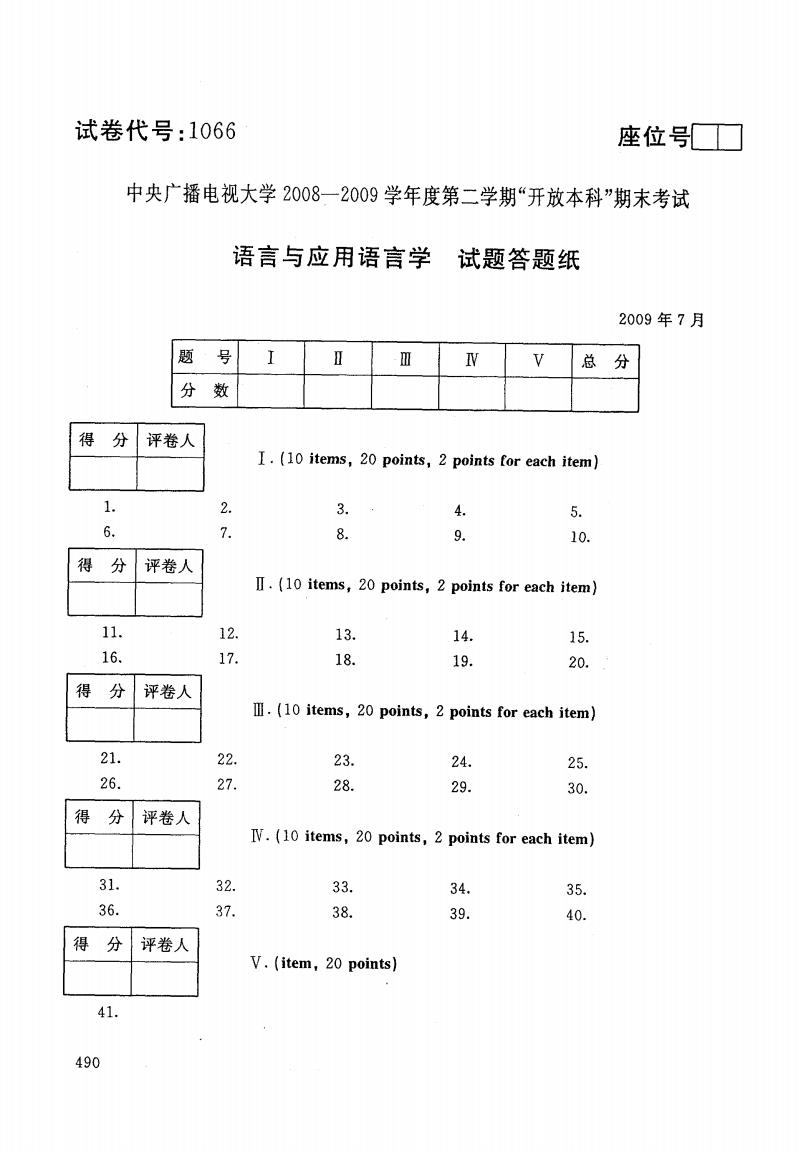
试卷代号:1066 座位号口 中央广播电视大学2008一2009学年度第二学期“开放本科”期末考试 语言与应用语言学试题答题纸 2009年7月 题 号 I W N V 总 分 分数 得分 评卷人 I.(10 items,20 points,2 points for each item) 1. 2. 3. 4. 5. 6. 7. 8 9 10. 得分 评卷人 II.(10 items,20 points,2 points for each item) 11. 12. 13. 14. 1 16. 17. 18. 19. 20- 得分 评卷人 II.(10 items,20 points,2 points for each item) 21. 22. 23. 24. 25. 26. 27. 28. 29. 30. 得 分 评卷人 IV.(10 items,20 points,2 points for each item) 31. 32. 33. 34. 35. 36. 37. 38. 39. 40. 得分 评卷人 V.(item,20 points) 41. 490
试卷代号:1066 座位号[三习 中央广播电视大学2008-2009学年度第二学期“开放本科”期末考试 语言与应用语言学 试题答题纸 2009年 7月 题 号 I n m N V 总 分 分 数 得 分 评卷人 I.(10 items, 20 points, 2 points for each item) 10 得 分 评卷人 1.(10 items, 20 points, 2 points for each item) 11. 16. 13. 18. 14. 19. 15. 20. 0 乙 叮矛 1 1 ,1 得 分 评卷人 1.(10 items, 20 points, 2 points for each item) 23. 28. 24. 29. 25. 30. 0 乙 甲 矛 勺 翻 勺 乙 21. 26. 得 分 评卷人 W.(10 items,20 points,2 points for each item) 33. 38. 34. 39. 35. 40. n乙 件 r 勺 d o d ..孟 叹 U 八j Q 口 得 分 评卷人 V.(item, 20 points) 41 490
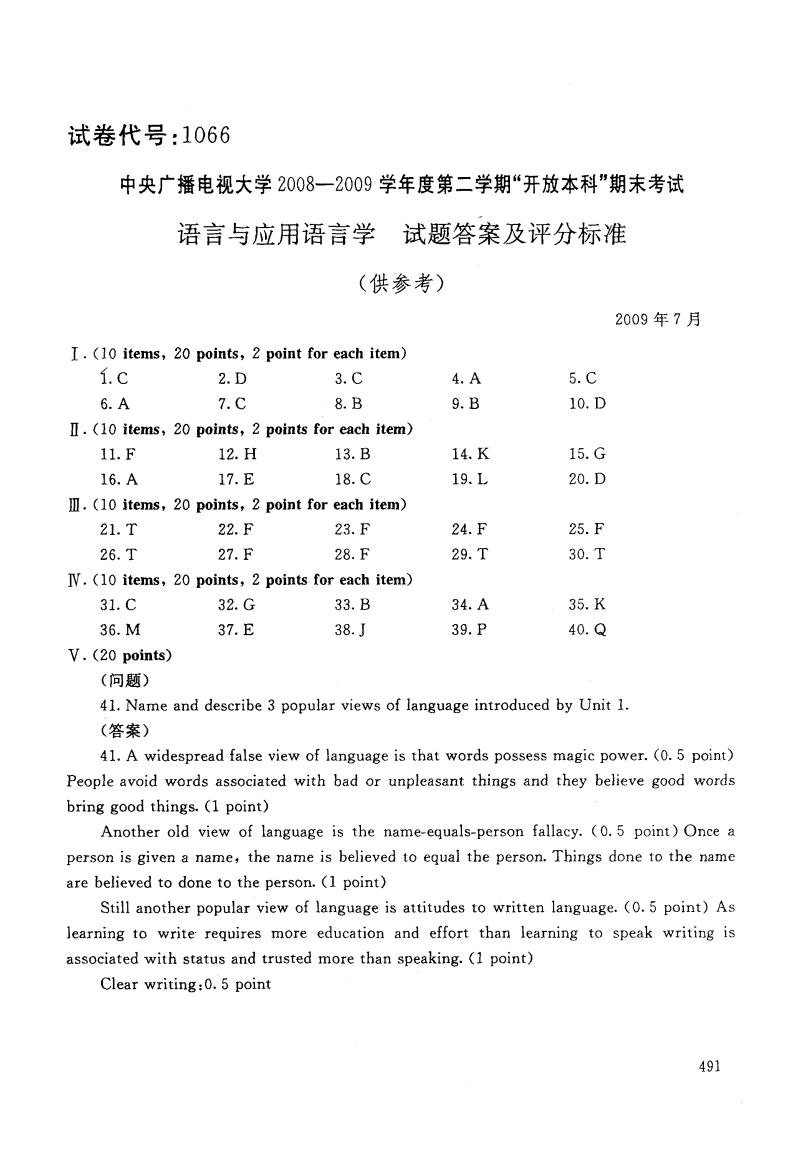
试卷代号:1066 中央广播电视大学2008一2009学年度第二学期“开放本科”期末考试 语言与应用语言学试题答案及评分标准 (供参考) 2009年7月 I.(10 items,20 points,2 point for each item) 1.c 2.D 3.C 4.A 5.C 6.A 7.C 8.B 9.B 10.D II.(10 items,20 points,2 points for each item) 11.F 12.H 13.B 14.K 15.G 16.A 17.E 18.C 19.L 20.D I.(10 items,20 points,2 point for each item) 21.T 22.F 23.F 24.F 25.F 26.T 27.F 28.F 29.T 30.T IV.(10 items,20 points,2 points for each item) 31.C 32.G 33.B 34.A 35.K 36.M 37.E 38.J 39.P 40.Q V.(20 points) (问题) 41.Name and describe 3 popular views of language introduced by Unit 1. (答案) 41.A widespread false view of language is that words possess magic power.(0.5 point) People avoid words associated with bad or unpleasant things and they believe good words bring good things.(1 point) Another old view of language is the name-equals-person fallacy.(0.5 point)Once a person is given a name,the name is believed to equal the person.Things done to the name are believed to done to the person.(1 point) Still another popular view of language is attitudes to written language.(0.5 point)As learning to write requires more education and effort than learning to speak writing is associated with status and trusted more than speaking.(1 point) Clear writing:0.5 point 491
试卷代号:1066 中央广播电视大学2008-2009学年度第二学期“开放本科”期末考试 语言与应用语言学 试题答案及评分标准 (供参考) 2009年 7月 I.(10 items, 20 points, 2 point for each item) 丁.C 2. D 3. C 4. A 5. C 6.A 7.C 8.B 9.B 10.D n.(10 items, 20 points, 2 points for each item) 11.F 12.H 13.B 14.K 15.G 16.A 17.E 18.C 19.L 20.D 19.(10 items, 20 points, 2 point for each item) 21.T 22.F 23.F 24.F 25.F 26.T 27.F 28.F 29.T 30.T W.(10 items, 20 points, 2 points for each item) 31.C 32.G 33.B 34.A 35.K 36. M 37. E 38. J 39. P 40. Q V.(20 points) (问题 ) 41. Name and describe 3 popular views of language introduced by Unit 1. (答案) 41.A widespread false view of language is that words possess magic power. (0. 5 point) People avoid words associated with bad or unpleasant things and they believe good words bring good things. (1 point) Another old view of language is the name-equals-person fallacy.(0. 5 point) Once a person is given a name, the name is believed to equal the person. Things done to the name are believed to done to the person.(1 point) Still another popular view of language is attitudes to written language.(0. 5 point) As learning to write requires more education and effort than learning to speak writing is associated with status and trusted more than speaking. (1 point) Clear writing:0. 5 point 491